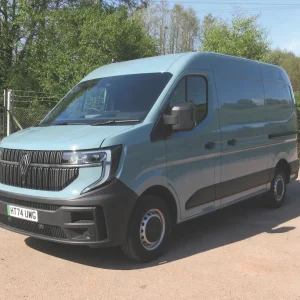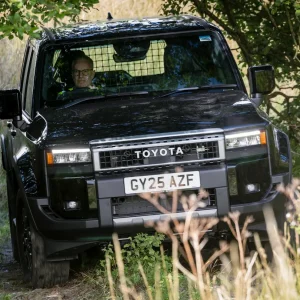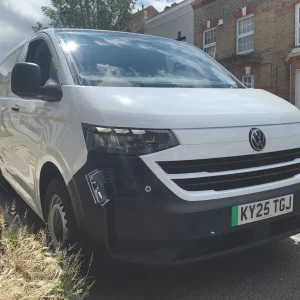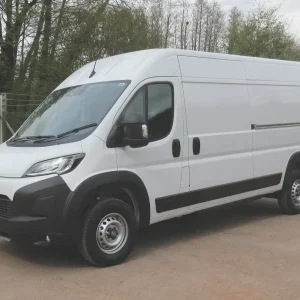It’s been a long time coming. Having first broken cover at the Sydney motor show more than a year ago, it made its UK debut at the Commercial Vehicle Show back in April.
What Van? was given the chance to put the eagerly anticipated pick-up through its paces as it arrived hot off the assembly line in South Africa.
The Ranger initially comes with a choice of two powertrains: a 2.2-litre 150hp Duratorq TDCi and a 3.2-litre 200hp Duratorq TDCi, mated to six-speed manual or automatic transmissions. A 125hp engine will follow. UK prices will range from £14,754, excluding VAT, for the single cab XL 4×2 2.2 125hp model to £24,279, excluding VAT, for the double cab Wildtrak 3.2 200hp auto. Trim levels are the entry-level XL, the mid-level XLT and the range-topping Limited and Wildtrak models, while both 4×2 and selectable 4×4 versions are offered.
The new Ranger certainly represents a major advance in comfort and sophistication compared with its utilitarian predecessor, but it joins a sector that has recently become more competitive with the arrival of the well-received VW Amarok.
Although the Mitsubishi L200 has long set the pace in the UK, in Europe as a whole the Toyota Hilux and Nissan Navara are the market leaders, and Ford has set these two rivals as its benchmarks, seeking to emulate and improve upon the best features of both models, particularly in terms of seating space and interior stowage.
Initial impressions
So how does the new Ranger shape up? We got to find out both on- and off-road.
First up was a 2.2 XLT 150hp 4×4 double cab with manual transmission and a maximum payload of 1152kg as well as best-in-class towing capacity of 3350kg. (In the UK 4×2 versions are available in just single and Super cab guises). Initial impressions were that the ride is slightly juddery, although this would almost certainly improve with a load on board. Once on slightly rougher, gravelly terrain, however, it soaked up the bumps well without transmitting the impact to the cab’s occupants.
The gear change is slick and well spaced and there is a surprisingly light touch to the new rack and pinion steering that Ford claims is a deliberate ploy to give the truck a more car-like driving feel as well as resist roll when cornering.
Power is more than adequate when on the highway, but the 3.2, 200hp unit we also tested in a Limited model certainly provides considerably more oomph when it comes to overtaking manoeuvres, especially when harnessed to the exceptionally smooth and responsive automatic transmission.
Inside the XLT cab the environment is understated and tasteful if not quite a match for the VW Amarok in terms of quality. Noise levels are well suppressed, which Ford says is a result of carefully tuned suspension and a frame that is 40% stiffer than that of the outgoing Ranger.
Extensive testing in wind tunnels has also contributed to a much quieter interior. The manufacturer says wind noise is 22% lower for both front and rear occupants in the new Ranger, and claims air leakage is 50% better than its competitors due to the introduction of a double-sealing system for doors and improvements to back panel and floor sealing.
The seats are comfortable and manually adjustable – as is the steering column for height and reach – and finished in cloth trim, but you get leather in the Limited and Wildtrak derivatives along with electrically adjustable seats.
There’s plenty of storage space, including a “kangaroo pouch” under the central console, and an easily reached, cleverly sloped surface that prevents keys or mobile phone from flying out during bouncy rides. In all, Ford says the interior contains 23 stowage compartments.
Manual air-conditioning comes as standard on XLT models, but to get the satnav and excellent rear view parking camera that comes as standard on the Wildtrak you’ll have to fork out £750. The XLT comes with two 12V power sockets in the front; with the Limited and Wildtrak you get another one in the back.
The XLT comes with a radio/CD player with multi-functional display, MP3 compatibility, matrix display, six speakers, remote audio controls, auxiliary and USB connections and Bluetooth. Controls are handily mounted on the steering wheel, as is cruise control.
The fascia knobs and switches on all Rangers are tough and robust-looking and, according to chief designer Craig Metros, the central console was inspired by the G-Shock watch.
The XLT, which is expected to be the UK’s biggest-selling specification, is priced from £19,362, excluding VAT. This is slightly more than the mid-spec VW Amarok, the Trendline, which costs £18,995 and sits in between Nissan’s Acenta and Tekna double cab Navaras. Meanwhile, the Toyota Hilux HL3 double cab looks a snip at £17,470.
Off-road the new Ranger demonstrates considerable prowess. Most customers are unlikely to need to call upon the full extent of its capabilities but it is here that the Wildtrak is set to come into its own by appealing to punters with a penchant for adventure and outdoor pursuits. The Ranger is able to negotiate fast-running rivers, boulder-strewn river beds and steep, slippery climbs and descents with the minimum of fuss.
Water wading
One of the new model’s claims to fame in 4×4 guise is its class-leading water-wading capability of 800mm. Another is its 232mm ground clearance.
“Our customers want a pick-up that is tough enough to withstand rough conditions and capable enough to handle any challenge thrown at it,” says Stephen Presser, vehicle engineering and product development boss from Ford Australia.
On both manual and automatic versions drivers can switch from 4×2 to 4×4 High mode via a knob on the centre console while traveling at any speed, and when off-road can engage 4×4 Low for extra low-speed torque or additional downhill breaking.
When the low-range gears are in use the throttle reaction changes to an off-road mode, which provides a less-sensitive pedal response to guard against accidental acceleration caused by unintentional heavy footedness when bouncing over bumpy terrain.
The Ranger’s ESP system incorporates off-road logic, which recognises when the vehicle is driven over rough surfaces and modifies the system to find the best balance between stability and intervention to prevent a hazard.
In 4×4 models the system can be partially switched off to disable under- and over-steer control as well as torque reduction while maintaining brake intervention traction control. This setting is designed for when driving through deep sand or mud so that momentum can be kept up and grip maximised. To aid pulling away in snow and ice the ESP has a setting to amend braking intervention.
A traction control system (TCS) has been designed to control wheel spin by delivering torque to the wheels with the most grip while braking a spinning wheel. Ford claims TCS provides superior traction, stability and acceleration than an alternative limited slip differential system could deliver, which it does not offer on the Ranger.
To avoid damage to the fuel tank on rocky surfaces Ford has placed it higher than the frame, while other components that could be at risk of impact, such as the engine and radiator, are protected by additional shields.
Raft of safety features
The Ranger is now the proud recipient of the first NCAP five-star crash test rating bestowed upon a pick-up. More remarkably, it has also achieved the highest score of any vehicle for pedestrian safety. Ford claims to have carried out 9000 simulated crashes on the Ranger during testing – it would appear they paid off.
The raft of safety features includes a passenger compartment reinforced with high strength steel. In a collision the manufacturer claims “crash forces are directed away from occupants”.
Ford claims to have broken new ground for a pick-up with the pedestrian technology fitted to the Ranger. This includes a “hexageneous” under-bonnet structure designed to reduce the severity of pedestrian head injuries and a front bumper design incorporating energy absorbing materials.
Other features include Hill Descent Control, to regulate speed when descending steep gradients, Hill Hold Assist, to guard against rolling backwards when heading uphill, and Trailer Sway Control, which mitigates problems caused by side winds or badly loaded trailers. Adaptive Load Control adjusts stability according to the load, and Roll-Over Mitigation triggers the ESP to kick-in to restore stability. When the driver uses the brakes in an emergency situation the Emergency Brake Assist applies additional pressure to increase braking force and reduce stopping distance. An Emergency Brake Light flashes the indicators to warn vehicles behind.
The company’s attention to the Ranger’s aerodynamics means it has eschewed sharp angles and the temptation to bulk-up the design with square shapes in favour of a sleeker profile. Nevertheless, the Ranger has a tough, imposing presence. Research indicated to Ford that customers wanted the Ranger to do what it says on the tin.
“People want it to look tough and also to be very capable,” explains Gary Boes, vehicle line director.
Metros continues the theme: “The truck has presence. Customers associate a tough- looking truck with capability but it’s more sophisticated.”
Signature design features include a three-bar grille and “outboard nostrils”, according to Metros, but he adds that all the components at the front are built to absorb energy or to break up upon impact “to get out of the way” in the event of a pedestrian collision.
The new Ranger definitely looks the part, and its composed and accomplished performance both on- and off-road, together with its bar-raising safety technology, suggests it is on course to shake up the established order in the pick-up sector.
Cultural revolution
Over the past three years the Ford Motor Company of South Africa (FMCSA) has embarked upon a mission to transform its Silverton assembly plant in Pretoria into one of the most productive and efficient in the Blue Oval brand’s global operation.
Silverton, together with factories in Thailand and Argentina, is producing the new Ford Ranger pick-up truck, and the manufacturer comprehensively overhauled the facility before production began getting into swing in October.
What Van? was part of an exclusive European group to be invited to view the revamped operation.
Silverton previously assembled other vehicles in Ford’s range, such as the Focus, Bantum (a half-tonne pick-up not available in the UK) and the current Ranger. It also produced vehicles for Mazda, the firm it used to own, such as the Mazda 3 and BT50 pick-up.
From now on though, the factory is to focus on the Ranger, which will account for about 80% of output, and its close relative the new incarnation of the Mazda BT50, which is based upon the Ford truck.
Ford has invested $500m (£317m) in FMCSA in preparation for the new Ranger, and making sure quality is second to none is something of an obsession for the company’s management. There are several notices inside the factory bearing the motto: ‘If it’s not error-proofed, it’s not fixed.’
Peter Lawson, vice-president operations for FMCSA, says Silverton has been “transformed” in preparation for the new Ranger from a plant producing four models in low volume to an operation geared up to build high volumes of one vehicle (the BT50 is effectively a re-badged Ranger).
“It is unrecognisable from three years ago,” says Lawson. “Every decision we make is quality driven.”
Lawson says it is crucial that customers recognise the high quality standard of the plant’s product in order to build up the image of FMCSA:?“We want customers to say, ‘I want a vehicle from that plant.’”
He claims every part of the factory is either new or has been given a complete upgrade.
An example of the technological revolution FMCSA has driven through is that the number of digitally controlled (DC) tools installed at Silverton has risen from 10 to 168 in the past 18 months.
From 2012, Silverton’s capacity will be 110,000 units a year with exports accounting for 75% of volume and covering 148 countries, according to Lawson, including the UK’s quota. The plant covers an area of 220,000sq/m under one roof and has a 1631-strong workforce.
Ford’s investment in South Africa has also covered its Straundale engine plant in Port Elizabeth. It now has an annual production capacity of 220,000 machined component kits, including the head, block and crankshaft for the 2.2- and 3.2-litre Duratorq TDCi engines that power the new Ranger. It produced its first sample engine for the new Ranger in November 2010.
As well as exporting parts to the Thailand and Argentina factories, Straundale is supplying 75,000 engines to Silverton.
Lawson was assigned to the Pretoria plant three years before production was due to start with a mission to make it a match for any other in Ford’s global commercial vehicle operation. It is a role he has performed before, notably in the manufacturer’s Chicago factory.
Of Silverton he says: “There has been an unprecedented cultural transformation.” This has involved what he refers to as a “war on waste” to eradicate inefficiencies.
The production process of the new Ranger has improved by 68% since 2009, according to the independent quality monitor TGW, which gauges the number of faults on batches of 1000 vehicles. Cutting the supply base by 50% to 60 parts providers has helped to drive up standards, Lawson explains. All the suppliers are based in South Africa, whether they are domestic or global companies.
Lawson brought in 10 international Ford experts, specialists in everything from paintwork to supply to bodybuilding, when he took on the Silverton project to enable the manufacturer to bring its “new vision” to fruition.
“By 2011 everything was in place for the pre-production phase,” Lawson says, and adds that “just prior to launch we parachuted in an array of people to ensure best practice.”
FMCSA also sent about 200 Silverton staff in batches of 18 workers to a model plant in India for what Lawson describes as “lean manufacturing training”. “We spent a tonne of time talking about getting people to have the right mindset,” he says.
“You’ve got to engage people so they intuitively understand and connect with the process.”
With the majority of the Rangers produced at Silverton set for export, they must come in a vast array of configurations to meet the requirements of different markets around the world. Versatility is therefore vital and the goal is for each worker to be competent in three jobs. This would also facilitate moving to a second shift.
Lawson split the employees into groups of 10 and initiated a ‘Five Star’ process by which they painstakingly work towards achieving excellence through gaining one star at a time by sustaining progress on various sections of the assembly line for three-month periods. Each star focuses on 11 elements of the production process.
“The South African culture is very proud – we have tapped into that. They want to be the best – the challenge is to enable that,” says Lawson.
Market forces
Ford entered the pick-up market in Europe back in the 1980s with the P1 Sierra, but times have changed considerably since then and in 1997 it became more serious about the segment with the launch of the original Ranger.
According to Nick Readings, sales and marketing chief for pick-ups in Europe, it now has a clear understanding of the customer base for the 2012 incarnation of the vehicle.
Not surprisingly, the bulk of buyers will be male, aged, Readings says, between 35 and 54 years. Owner/operators will be self-employed family men with children – practical, competitive and with a serious interest in outdoor leisure pursuits. The Ranger will also generate a lot of business from large fleets based in forestry or the utility industries such as electricity, gas and water suppliers.
The UK is Ford’s biggest market for pick-ups in Europe, accounting for up to 30% of sales, Readings says, which is likely to work out at 7000 to 9000 units a year depending on the overall total. He
points out that pick-up sales across Europe slumped from 158,000 in 2007 to 80,000 in the recession. But the good news is that the mid-sized commercial vehicle sector, which includes the Ranger, is
up 14% this year.
Diesel dominates the European pick-up market, accounting for 98% of volume, and Ford only sells petrol-powered models in Russia.
The new Ranger will be available in three body styles: double cab, super cab and single cab. The double cab will take at least 70% of business.
Ford will offer the truck in both 4×4 and 4×2 guises, but in the UK, like in the rest of Europe, the four-wheel drive iteration will dominate, taking nine out of 10 sales.
“The whole purpose is that people want capability,” Readings says. “Whether fleet or private, the whole business is going off-road.”
This begs the question as to why Ford bothered making the on-road version, but Readings says a minority of customers just want the load-lugging capacity, and added that the 4×2 is more popular outside Europe.
The new Ranger comes in four specifications: the lead-in model is the XL, then comes the XLT, expected to be the best-seller due to its fleet appeal, and the range-toppers are the Limited and the Wildtrak. Of these the former is set to tempt “sophisticated” city users while those with a few bob to spare and a serious interest in outdoor leisure pursuits will like the cut of the Wildtrak’s gib. Nobody will buy these flagship models for use in the construction industry, Readings concedes.
“The Limited and Wildtrak are lower volume. It’s the fleets that buy in volume,” he says.
Verdict
The eagerly anticipated new Ranger does not disappoint. Impressive on- and off-road, it marks a huge advance on its predecessor and will undoubtedly challenge the segment leaders.





